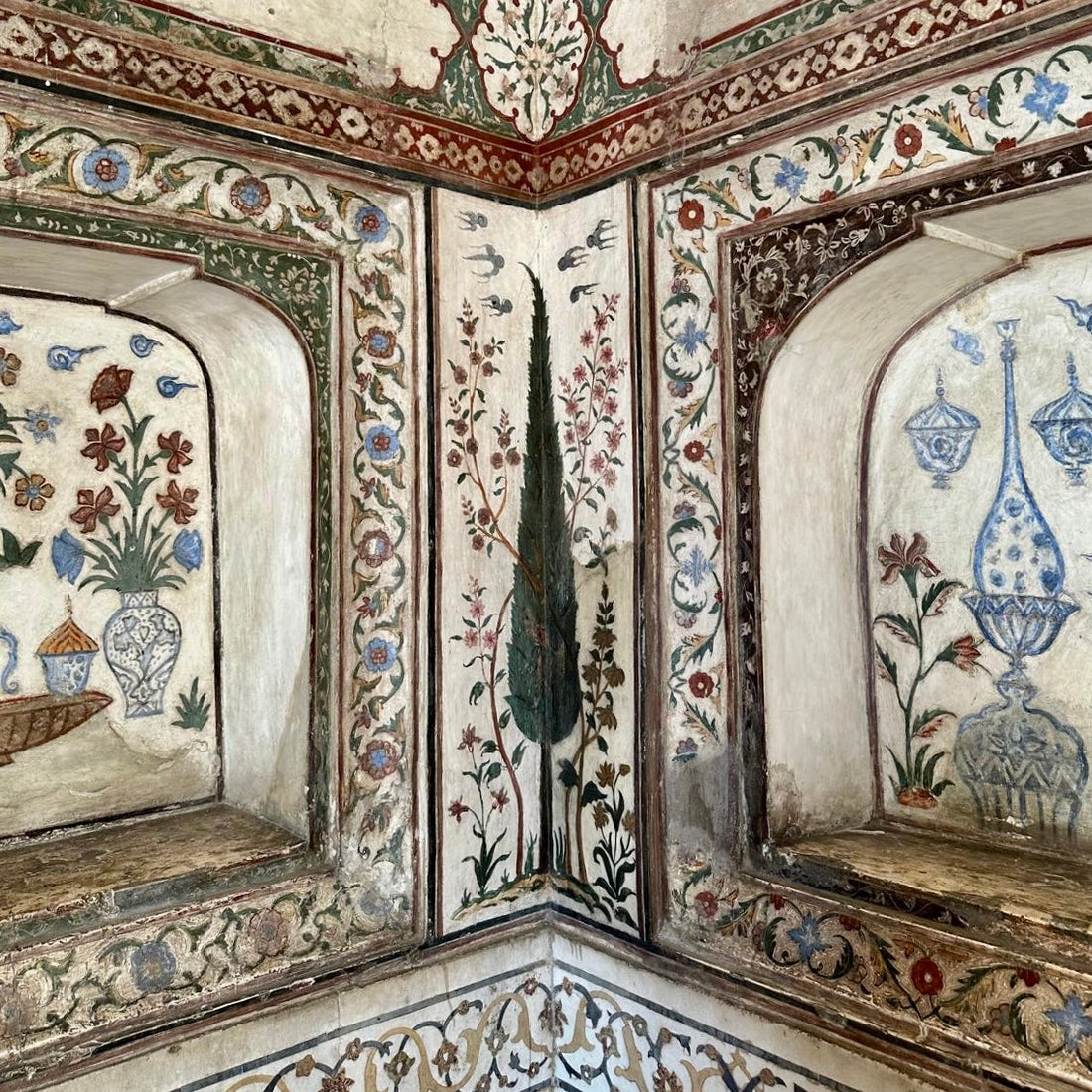
Selvedge Textile Tour 2025: Week Two
Welcome to the second collection of discoveries from the Selvedge India Textile Tour so far. This week has been a convergence of colour, pattern, and technique in a wide range of wonderfully designed architectural settings, both ancient and modern.
 Hand Weaving at Ganga Maki
Hand Weaving at Ganga Maki
Ganga Maki Textile Studio
As week two of the Selvedge Textile Tour unfolds, Polly’s journey has led her to the remarkable Ganga Maki Textile Studio, a craft oasis nestled in the Himalayan foothills near Rishikesh. Founded by Japanese textile designer Chiaki Maki and local entrepreneur Rakesh Singh, this workshop is a hub for hand-weaving, and a testament to how textile craft can harmonise with architecture in a natural environment.
 Preparing the Cocoons for Silk Extraction
Preparing the Cocoons for Silk Extraction
Polly observed each step of the studio’s meticulous process - from the delicate transformation of silk cocoons into fine fibre to expert spinning, natural dyeing, and, finally, the intricate hand-weaving that produces exquisite garments and home textiles. Every stage is carried out with precision, rooted in traditional techniques and imbued with a contemporary sensibility.

 Silk Yarns - Naturally Dyed with Indigo. Dipped and Resting in the Shade.
Silk Yarns - Naturally Dyed with Indigo. Dipped and Resting in the Shade.
 Hand-weaving the Yarns into Ganga Maki Creations
Hand-weaving the Yarns into Ganga Maki Creations
Designed by Bijoy Jain of Studio Mumbai, the studio itself is as handcrafted as the textiles it produces. Built with local stone, brick, and lime, alongside bamboo and marble sourced from across India, the structure of the studio is serene, and surrounded by the tranquility of nature.
-
 Polly's View from a Traditional Shikara Boat
Polly's View from a Traditional Shikara Boat
Dal Lake of Srinagar: A Shikara Cruise
Next, Polly took a gentle sail across Srinagar’s tranquil waters aboard a traditional Shikara boat. Much like Venetian gondolas, these elegant vessels are cultural emblems. Crafted from deodar wood which is prized for its water resistance, the boats range from 25 to 41 feet in length and feature canopies and interiors adorned in vibrant fabrics, intricate engravings, and polished embellishments.
 Views from Dal Lake
Views from Dal Lake
As Polly glided across the lakes, she took in the dazzling hues and rhythmic patterns of the boat’s painted exteriors, a striking contrast against the stillness of the water.
 Houseboats along the shore of Dal Lake, Srinagar
Houseboats along the shore of Dal Lake, Srinagar
She marvelled at the breathtaking landscape surrounding the lake - misty hills and towering Chinar trees reflecting on the surface - while the ornate houseboats, with their carved wooden facades, stood strong as testaments to Kashmir’s rich craft traditions. The journey offered a glimpse into a slower, more poetic rhythm of life.
-
 The Taj Mahal
The Taj Mahal
Design at Ornamentation at the Taj Mahal
A visit to Agra wouldn’t be complete without time spent at the Taj Mahal - a masterpiece of Indo-Islamic architecture and a timeless symbol of devotion. Wandering through its symmetrical gardens and marble courtyards, Polly admired the intricate stone inlays, delicate hand-painted motifs, and carefully carved embellishments that adorn its ivory-white surfaces.
 Marble Carvings in the Taj Mahal Interior
Marble Carvings in the Taj Mahal Interior
Built in the 17th century by Mughal Emperor Shah Jahan, the mausoleum stands as an enduring tribute to his beloved wife, Mumtaz Mahal. The Indian architect Ustad Ahmad Lahori was entrusted with its design, creating a structure so harmonious and precise that it exudes serenity and balance. The iridescent marble catches the shifting light, its luminous quality enhancing the air of quiet grandeur that surrounds it. A resting place fit for a queen - one that continues to captivate all who stand before it.
-
 The Interior of Itmad ud Daulah
The Interior of Itmad ud Daulah
Itmad ud Daulah: The 'Jewel Box' Mausoleum
While in this area, Polly visited Itmad ud Daulah, often called the ‘Little Taj.’ Across the river from the Taj Mahal, this exquisite mausoleum, commissioned by Nur Jahan for her father, is a masterpiece of Mughal ornamentation.
 Adorned Ceilings with Precious Stones and Shimmering Paintwork
Adorned Ceilings with Precious Stones and Shimmering Paintwork
Unlike the Taj Mahal’s smooth marble expanse, Itmad-ud-Daulah shimmers with intricate inlays - carnelian, lapis lazuli, and topaz encrust the ceilings above, and delicate motifs of cypress trees, wine vases, and floral bouquets flow with life across the walls. The monument’s jali screens, arabesque patterns, and mosaic embellishments echo the precision of fine textile work, providing another source of inspiration for Polly on her journey through India’s rich textile heritage.
-
 Zardozi Embroidery at Shams Embroidery Workshop
Zardozi Embroidery at Shams Embroidery Workshop
Sparkling Stitches: Zardozi Embroidery
To round off her week of architectural and artistic exploration, Polly visited the workshops of Shams Embroidery in Agra, where the dazzling craft of Zardozi embroidery continues to thrive. Once reserved for Mughal royalty, this intricate technique layers gold and silver threads with precious stones and pearls, creating embellishments that are jewel-like and gleaming, much like that of the ceilings in the Itmad ud Daulah. Rich colours contrast vibrantly on their deep, lush, velvety backgrounds, while the stones sparkle candy-like and gleaming on their bed of golden threads.

Traditionally adorning royal garments, ceremonial tents, and even the regalia of elephants and horses, Zardozi embroidery remains an opulent expression of Indian craftsmanship. Watching artisans stitch these intricate motifs onto velvet and silk, Polly witnessed how this centuries-old craft continues to shine in contemporary textiles.
-
The official textile tour begins today, and at the time of posting this article, the attendees are gradually arriving in the region to meet Polly. We hope you'll join us again next week here at Selvedge Stories, for more fascinating insights into their journey discovering the textiles of India.
